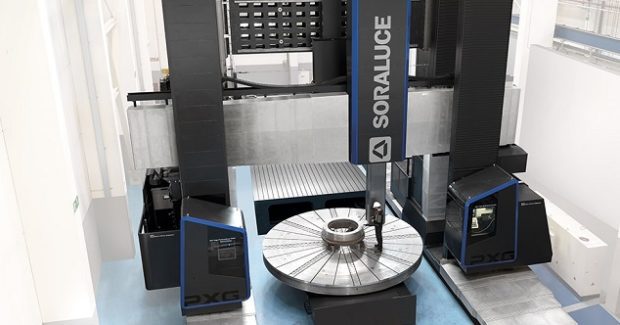Machining of Gas and Steam Turbine Casings and More
The PXG multi-tasking gantry milling machine from SORALUCE maximizes productivity and minimizes set-up time for turning, milling, boring, drilling and threading complex gas and steam turbine casings, CHP motors, parts used in the construction of machinery for the energy industry, and the general machining of other large workpieces.
Posted: February 14, 2018
The highly versatile PXG multi-tasking gantry milling machine from SORALUCE America, Inc. (Chicago, IL) maximizes productivity and minimizes set-up time while meeting the demanding machining requirements for complex gas and steam turbine casings, CHP motors, parts used in the construction of machinery for the energy industry, and the general machining of other large workpieces. This machine has a working volume of 1000 m3 and weighs 500 tons. It is 19 m long with 7.25 m clearance between columns and 7.3 m tall. Its height is configurable through the 5 m vertical travel of the crossbeam. By handling turning, milling, boring, drilling and threading operations, the PXG provides the highest possible return in the complete machining of a wide range of large shapes and sizes with a high degree of technical complexity. It can be equipped with several milling and turning heads with automatic tool changing, and features the latest innovative technologies for large-sized machining.
The turning process often creates long chips that traditional chip conveyor systems cannot deal with, leading to production stoppages that require manual removal from the machine. The Chip Breaker system in the PXG breaks long chips and eases chip removal by using the drives of the machine to create an oscillation that produces small chips which are easier to remove. This reduces machine downtime and ensuring continuous production. The PXG has linear guides on the X, Y and Z axes that provide certain advantages over conventional systems, such as hydrostatic guides: the linear guiding system avoids the thermal gradients caused by the flow of oil through the structure of the machine, ensuring better geometrical stability and substantially reducing the maintenance required.
The turning table is fitted with sensors that help the operator re-balance the weight of parts with asymmetrical geometries. A number of devices in the PXG largely offset the deformations caused by the weight of those moving parts. One is the innovative, patent pending Vertical Ram Balance (VRB) that consists of a CNC-controlled electromechanical system that offsets the rolling caused by the torsion of the cross beam and the differential bending of the columns when the ram travels along the cross (Y) axis of the machine. This system ensures maximum precision in terms of the perpendicularity of the X and Y axes, whatever the working position. A thermal monitoring system also checks for changes over time in all structural components of the machine via a function built into the CNC that uses the latest thermal compensation algorithms.
The Data System on the PXG is a machine data-driven analytics tool that extracts valuable insights from machine-generated data and monitors its status and condition to ensure that the running performance of the machining process is as high as possible to maximize uptime and manufacturing efficiency. The Data System displays machine status in real time for relevant information about the machining situation in progress. It generates reports on production or process, energy consumption, or the performance of the machining cycles and helps optimize machining process variables through the diagnosis of key warning signs related to the maintenance of the equipment. This increases machine productivity and avoids unnecessary consumption. The Data System also sends emails automatically in the event of a shutdown.
The Data System collects and stores significant data from the CNC, PLC and sensors built into the PXG and uses them to analyze the machining process and machine behavior. Users can connect to the system remotely and securely via laptops, smartphones and tablets for access to all the relevant information of the machine, the factory logistics systems, or other machine tools in the production system. The Data System also allows the PXG to connect with other machines in the factory and with different management software applications, such as ERP, MES and GMAO.
A Heidenhain TNC 640 touch screen HMI provides a user-friendly operator interface for Advanced Tool Management, recovery of procedures (indexing head, tool changer, pickup station) after machine interruptions, diagnosis of functions, and 3D machine modeling for Dynamic Collision Monitoring. Operators have access to 3D drawings, an operation and diagnostics handbook, or the INDEXMILL proprietary software tool for calculating the position of the head. When a vibration problem arises, the patented DAS® (Dynamics Active Stabilizer) system maximizes the cutting capability of the machine with long ram overhangs where the dynamic stiffness of the machine is weaker. It increases the dynamic rigidity of the machine in real time, increasing the machining performance by up to 300 per cent and reducing the regenerative effect of chatter while machining.
DAS+® includes vibration level monitoring, detection of chatter and two extra strategies to suppress chatter: spindle speed tuning and spindle speed variation functions. This function monitors the machining process and runs an internal algorithm that looks for the best cutting conditions to increase the stability of a particular operation. In the event of instability, the algorithm considers the chatter and excitation frequency generated by the tool and selects the best strategy to overcome the problem, automatically activating the DAS+ system and selecting the optimal spindle speed where chatter is suppressed or introducing a continuous harmonic oscillation in the spindle during the machining process. This enables the PXG to become an assistant for the operator that can concentrate on maximizing the use of its capabilities. DAS+ makes the machine more intelligent and increases productivity through reduced cycle times, longer tool life, a significant improvement of part surface quality and reduced machine wear.
SORALUCE America, Inc., 875 N Michigan Avenue, Suite 3614, Chicago, IL 60611, 815-315-9261, Fax: 312-205-0358, www.soraluce-america.com.















